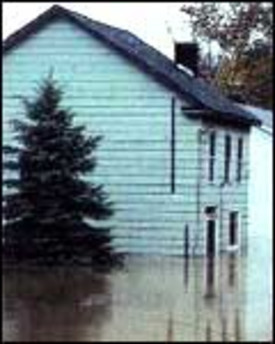Remove Standing Water
Standing water is a breeding ground for microorganisms, which can become airborne and be inhaled. Where floodwater contains sewage or decaying animal carcasses, infectious disease is of concern. Even when flooding is due to rain water, the growth of microorganisms can cause allergic reactions in sensitive individuals. For these health reasons, and to lessen structural damage, all standing water should be removed as quickly as possible.
Dry Out Your Home
Excess moisture in the home is an indoor air quality concern for three reasons:
- Microorganisms brought into the home during flooding may present a health hazard. These organisms can penetrate deep into soaked, porous materials and later be released into air or water. Coming in contact with air or water that contains these organisms can make you sick.
- High humidity and moist materials provide ideal environments for the excessive growth of microorganisms that are always present in the home. This may result in additional health concerns such as allergic reactions.
- Long term increases in humidity in the home can also foster the growth of dust mites. Dust mites are a major cause of allergic reactions and asthma.
Be patient. The drying out process could take several weeks, and growth of microorganisms will continue as long as humidity is high. If the house is not dried out properly, a musty odor, signifying growth of microorganisms, can remain long after the flood.
Remove Wet Materials
It can be difficult to throw away items in a home, particularly those with sentimental value. However, keeping certain items that were soaked by water may be unhealthy. Some materials tend to absorb and keep water more than others. In general, materials that are wet and cannot be thoroughly cleaned and dried within 24-48 hours should be discarded, as they can remain a source of microbial growth.
You may be able to dry out and save certain building materials (for example, wallboard, fiberglass insulation, and wall-to-wall carpeting that were soaked only with clean rain water). You may, however, want to consider removing and replacing them to avoid indoor air quality problems. Because they take a long time to dry, they may be a source of microbial growth.
In addition, fiberboard, fibrous insulation, and disposable filters should be replaced, if they are present in your heating and air conditioning system and have contacted water. (If a filter was designed to be cleaned with water and was in contact with clean rain water only, ensure that it is thoroughly cleaned before reinstalling.)
Avoid Problems from the Use of Cleaners and Disinfectants
The cleanup process involves thorough washing and disinfecting of the walls, floors, closets, shelves, and contents of the house. In most cases, common household cleaning products and disinfectants are used for this task. FEMA also suggests the use of disinfectants and sanitizers on the duct work for the heating and air conditioning system, if it has been flooded.
Disinfectants and sanitizers contain toxic substances. The ability of chemicals in other household products used for cleaning to cause health effects varies greatly, from those with no known health effect to those that are highly toxic. Read and follow label instructions carefully, and provide fresh air by opening windows and doors. If it is safe for you to use electricity and the home is dry, use fans both during and after the use of disinfecting, cleaning, and sanitizing products.
Be careful about mixing household cleaners and disinfectants together. Check labels for cautions on this. Mixing certain types of products can produce toxic fumes and result in injury and even death.
Avoid Carbon Monoxide Poisoning
Carbon monoxide (CO) is a colorless, odorless gas that can be lethal at high levels. Carbon monoxide levels can build up rapidly if certain types of combustion devices (for example, gasoline-powered generators, camp stoves and lanterns, or charcoal-burning devices) are used indoors. Do not use combustion devices designed for outdoor use indoors.
Avoid Problems from Airborne Asbestos and Lead Dust
Elevated concentrations of airborne asbestos can occur if asbestos-containing materials present in the home are disturbed. Airborne asbestos can cause lung cancer and mesothelioma, a cancer of the chest and abdominal linings. If you know or suspect that your home contains asbestos, contact the EPA TSCA Assistance Information Service at (202) 554-1404 for information on steps you should take to avoid exposure.
Lead is a highly toxic metal which produces a range of adverse health effects, particularly in young children. Disturbance or removal of materials containing lead-based paint may result in elevated concentration of lead dust in the air. If you know or suspect that your home contains lead-based paint, contact the EPA lead hotline at 800 LEAD-FYI for information on steps you should take to avoid exposure.




























